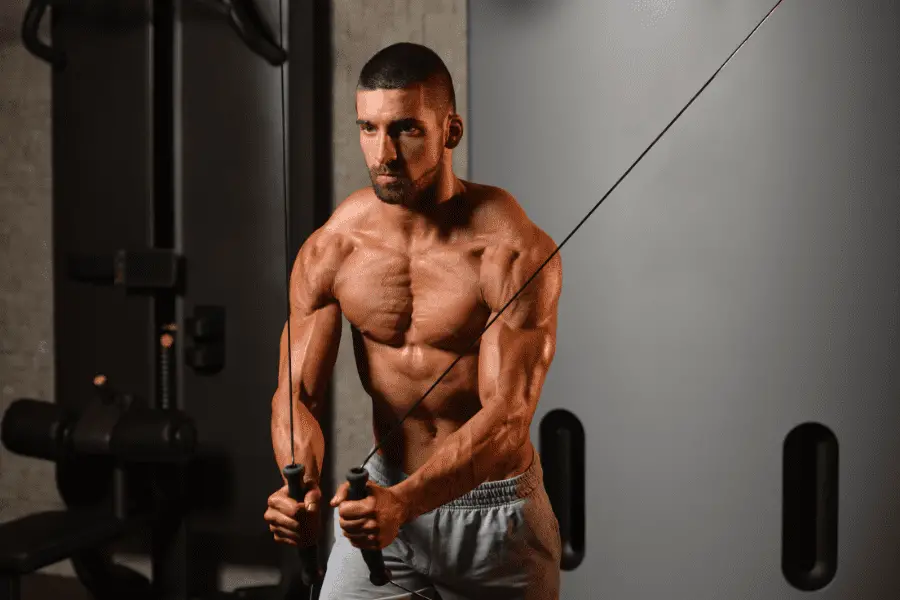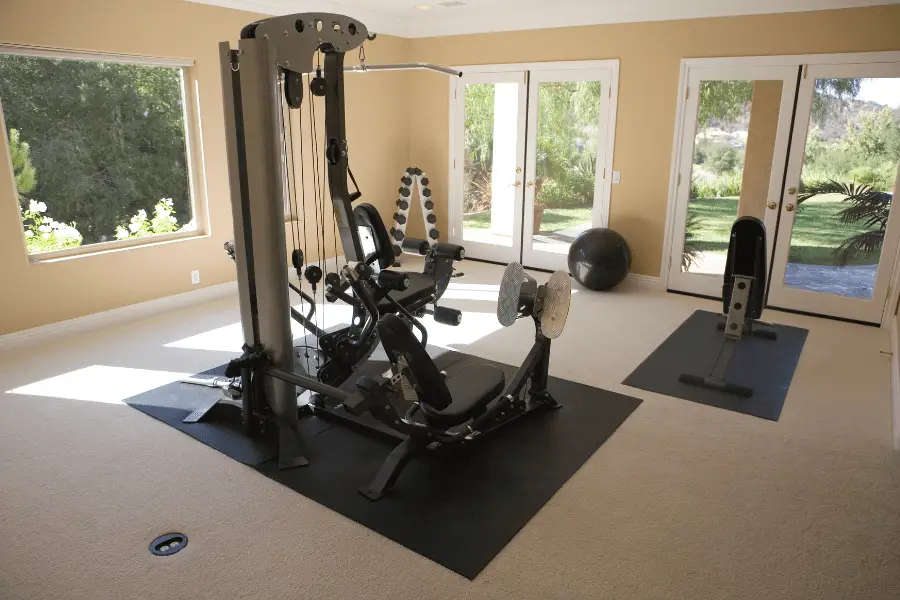Functional trainers, also known as cable crossovers are an expensive bit of equipment, especially for a home gym. Do they have enough to offer that they are worth the money and space?
Functional trainers are expensive but worth it because they provide all the exercise options you need in a single machine. They provide the benefits of both free weights and fixed machines without most of the drawbacks of either of them.
Read more about the details of cost, benefits, requirements, and how functional trainers compare to other types of workout equipment below.
Contents
Is a Functional Trainer Worth The Investment?

In my view, even though functional trainers can be pricey, they’re definitely worth the investment, especially if you’re considering a quality one that costs around $2500. The versatility they offer is challenging to match with just one piece of equipment.
Certainly, you could use the same amount of money to buy a high-quality power rack, barbell, and weights. However, this setup is geared towards individuals aiming to become very strong and muscular. For most people who simply want to get in shape and might feel a bit overwhelmed by free weights, a functional trainer is a better fit. It provides more exercise options compared to a barbell setup, and you’d need a full set of dumbbells to achieve a similar level of functionality.
Despite taking up a similar or slightly less amount of space than a power rack and barbell, a functional trainer offers a broader range of exercises.
While free weights have their advantages, a functional trainer is simpler since you only need one piece of equipment. It’s also more approachable for most people, including those who might find lifting weights intimidating. For example, your grandma could likely use a functional trainer without any issues, as it’s less intimidating than getting under a barbell. Additionally, working out on a functional trainer poses less risk of injury compared to free weights.
To summarize, functional trainers are:
In the end, it’s personal preference if you choose a functional trainer or other home gym setup. But, if you’re not interested in using barbells or dumbbells but still want to build muscle and strength, a functional trainer is easily the best alternative.
Deciding If A Cable Crossover Is For You
How Much Do Functional Trainers Cost?
The most important factor in deciding if something is worth the money is how much something costs, compared to how much benefit it brings. How much something costs is the most important part of that puzzle.
Luckily I’ve already done the research for that for another post. Here is the summary;
Functional trainers can cost anywhere from $1100 to $7000+. The average price of a functional trainer is about $3750. It’s possible to buy a high quality but basic functional trainer that can provide a great workout with plenty of resistance for $2000 – $3000
https://homegymresource.com/how-much-does-a-functional-trainer-cable-home-gym-cost/
So you can expect to pay about $2000 to $3000 for a good functional trainer without any special features. Want to find a good functional trainer in that price range which is. high quality, made by a good brand, and backed up by a lifetime warranty? Click here to find it.
What’s a Cable Station Good For?
A functional trainer is a tool designed for a type of exercise called functional training (training on your feet). They have two height-adjustable pulleys with cables you can attach different attachments. This means a single functional trainer can be used to train pretty much every muscle in your body.
They’re great for adding muscle and real-world strength while being much more approachable than free weights (barbells, dumbbells).

Cable gyms also have the benefit of providing an even strength curve which puts more stress on your muscles resulting in more muscle growth compared to using the same resistance on a barbell or dumbbell. However, on the flipside you can usually use dumbbells or barbells with higher weights so they still win in the end.
Functional training with a functional trainer is also good for your core and stabilizing muscles. These are the muscles that help you stay balanced and support your spine. By working on these muscles, functional training can improve your coordination and balance.
The resistance on a functional trainer is adjustable, which means you can make your workouts harder or easier. This makes it good for people who are just starting out as well as those who are more advanced. The controlled movements in functional training can also lower the risk of injuries compared to some other types of exercises.
Overall, a functional trainer is a good choice for people who want a versatile, efficient, and safe way to improve their overall fitness and strength. Whether you’re just starting out or are an experienced exerciser, the adaptable nature of functional training can cater to different fitness levels and goals.
Space Requirements
Functional trainers themselves have a footprint of roughly 4′ x 5′. Sometimes bigger, sometimes smaller but that’s about the average. Compact versions can take up as little floor space as 3.3′ x 4.5′. Additionally, most home models are built to fit in a 90-degree corner which makes them easy to place anywhere.
They’re fairly compact but be aware that you’ll want some free space in front of the machine as well. You want about 5′ of free space in front of the pulleys to make sure you can perform all the exercises. It’s also a good idea to have at least one foot of free space on each side of the pulley.
That means in total the average cable crossover needs 9′ x 7′ of free space which is very comparable to a barbell and rack setup.
Maintenance and Durability

A good cable crossover can last for 15 years or more but it’s important that they’re maintained. These machines will take a little more time and effort to keep working well than a barbell and rack but in the grand scheme of things, it’s not that much.
Some lubrication is all they need most of the time. When cables, pulleys, or attachments break/wear out, they have to be replaced but that should be once every few years only (for domestic use).
Pros and Cons of Cable Crossover Machines
Cable Crossover Vs. Alternatives For a Home Gym
Functional Trainer vs. an All-In-One Home-Gym

Let’s compare a functional trainer to a home gym, specifically a multi-gym. Like cable machines, multi-gyms combine various machines into one. However, they have fixed movement patterns, and you usually sit for most exercises. While this might seem convenient, it actually removes the use of stabilizing muscles.
On the other hand, a functional trainer challenges your stabilizing muscles because its cables can move in any direction. This not only builds better real-world strength but also reduces the risk of injury. Additionally, functional trainers have you standing, mimicking movements you’d encounter in everyday life, hence the ‘functional’ in the name.
Multi-gyms lack flexibility for different body sizes, but functional trainers can be adjusted to fit anyone. Functional trainers also offer more exercise options compared to all but the biggest and most expensive home gyms.
Both multi-gyms and functional trainers are similar in price and space requirements. However, the functional trainer stands out for its versatility and ability to cater to various body sizes, providing a more functional and effective workout.
Functional Trainers vs. Free Weights

If you already have a barbell and dumbbell setup, you can do most important exercises for a full-body workout. However, adding a cable machine, like a functional trainer, can work your muscles in a different way, providing extra training benefits. Consider getting a functional trainer if you aim to elevate your training or make your home gym more user-friendly for family members who might be hesitant about using barbells.
For those starting with an empty home gym, your choice depends on your goals, budget, and space. A functional trainer is suitable for anyone wanting to work their muscles, regardless of whether you aim to gain or lose weight or maintain your current size. Functional trainers are user-friendly and offer advantages over both free weights and machines.
If your goal is significant muscle growth and strength, a barbell setup is preferable because barbells allow you to lift heavier weights. This setup is also better if you focus on deadlifts and squats. While a functional trainer adds value alongside a barbell setup, budget and space constraints often make the barbell a priority.
Suggested: Functional trainers with the highest resistance
However, if your goal is moderate muscle growth and overall fitness, a functional trainer is an excellent starting point. Personally, I appreciate free weights, but I acknowledge that a functional trainer is more accessible, helping more people achieve better fitness. So, for those looking for a balance between muscle growth and general fitness, a functional trainer is a favorable choice.
Best Cable Machine Accessories
Make your cable trainer experience even better with these accessories.
- Attachments: No cable machine is complete with a good set of attachments. Click here to find the best set of attachments
- PlateMate: One or two platemates (Amazon link) can help you increase the weight more gradually on your weight stack. Just stick them onto your weight stack.
- Bench: A good adjustable weightlifting bench like the CAP Deluxe (Amazon) adds many exercise options to a cable machine like bench presses and shoulder presses.
Find the most complete functional trainer that includes most of these accessories by clicking here.
